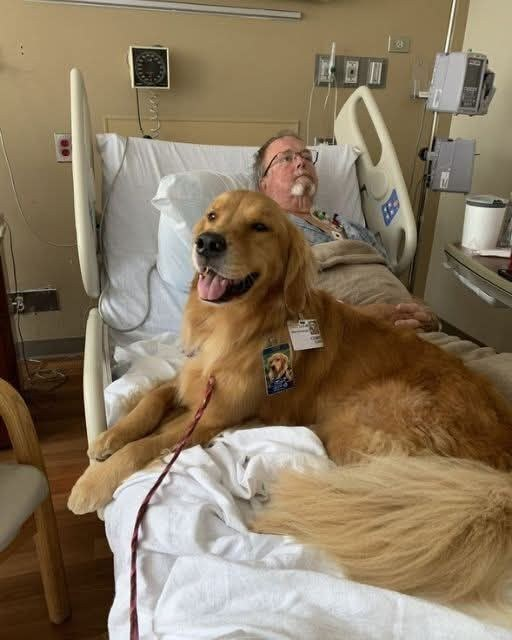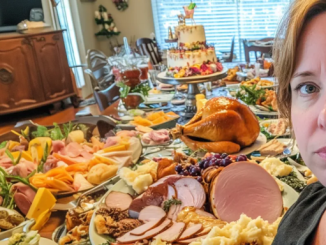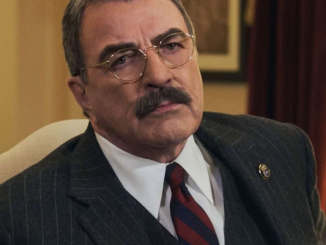
But what he said next… none of us were prepared for.
“Marigold…” The word slipped out like a forgotten melody, fragile but clear.
“Marigold?” I repeated softly, unsure if I’d heard correctly.Mr. Callahan turned his head slightly toward me, his cloudy blue eyes flickering with something that resembled recognition. “She used to bring me flowers every Sunday. Marigolds. Said they matched my hair when I was young.” A faint smile played on his lips as he scratched behind Riley’s ears absentmindedly. “She always brought them, even after…” His voice trailed off, leaving the sentence unfinished, heavy with unspoken memories.
The nurse beside me shifted uncomfortably. She leaned in closer to whisper, “He hasn’t mentioned anyone by name in months. Not since…” Her voice faltered, and she didn’t finish her thought either.
Riley tilted his head, sensing the change in energy, and let out a soft whine. It seemed to snap Mr. Callahan back to the present. He patted Riley’s side lightly before looking at me again. “You remind me of her,” he said suddenly, surprising both of us. “The way you look at your dog. She had a way with animals too.”
My throat tightened. I wasn’t sure how to respond, so I just smiled warmly and asked, “Who was she?”
For the first time since we entered the room, Mr. Callahan sat up a little straighter. His gaze softened as though he were peering through decades of memory. “Her name was Eleanor. We grew up together in a small town nobody’s ever heard of. She was the only person who believed I could do anything worthwhile with my life.” He paused, his fingers brushing against Riley’s fur absently. “We got married right out of high school. Everyone thought we were crazy—young kids tying themselves down—but it worked. For fifty years, it worked.”
His words hung in the air, thick with nostalgia and longing. But there was also an undercurrent of pain, a shadow lurking beneath the surface of his story. Something about his tone told me this wasn’t going to end happily.
“What happened?” I asked quietly, bracing myself for whatever came next.
His face darkened, and for a moment, I wondered if he’d retreat back into silence. Instead, he sighed deeply, the weight of years pressing down on him. “Eleanor passed away two years ago. Cancer. They said it was quick, but it didn’t feel that way to me. Watching someone you love waste away… it takes longer than you think.” He swallowed hard, his hands trembling slightly. “After she was gone, everything felt empty. I stopped talking. Stopped eating. Stopped caring. Even the marigolds in our garden died because I couldn’t bring myself to water them anymore.”A lump formed in my throat. I glanced at the nurse, whose eyes were glistening with tears. This was more than just a patient reconnecting with the world—it was a man rediscovering pieces of himself he’d buried along with his wife.
Riley must have sensed the shift too because he nudged Mr. Callahan’s arm, drawing his attention back to the present. The old man chuckled weakly, scratching Riley’s neck. “You’re persistent, aren’t you? Just like Eleanor used to be.”
That’s when it hit me—the twist no one saw coming. Maybe it wasn’t just coincidence that Riley had sparked this breakthrough. Dogs have a way of connecting people to their deepest emotions, bridging gaps we don’t even realize exist. And maybe, just maybe, Riley wasn’t here by chance.
As if reading my thoughts, Mr. Callahan added, “You know, Eleanor always wanted a dog, but we never had space for one. She would’ve loved him.” He gestured toward Riley, who wagged his tail enthusiastically. “Maybe she sent him to find me.”The room fell silent except for the rhythmic ticking of the clock on the wall. It wasn’t a religious statement or a supernatural claim—it was simply a man finding comfort in the idea that love transcends even death. That somehow, somewhere, Eleanor was still looking out for him.
Before I could respond, Mr. Callahan surprised me once more. “Can you take me outside? I haven’t been out in weeks.” His voice carried a mix of determination and vulnerability, like a child asking permission for something they desperately needed.
I exchanged a glance with the nurse, who nodded approvingly. “Of course,” I said, helping him sit up fully. With Riley leading the way, we slowly made our way to the hospital courtyard. The sun was setting, painting the sky in hues of orange and pink. Mr. Callahan took it all in, his eyes wide with wonder, as though seeing the world anew.
When we reached a bench surrounded by flower beds, he stopped and pointed to a cluster of bright yellow blooms. “Marigolds,” he said softly, his voice cracking. “They planted marigolds here.”Without another word, he sat down, leaning forward to touch the petals. Tears streamed down his face, but they weren’t tears of sadness—they were tears of gratitude, of remembrance, of love renewed.
Later that evening, as I tucked Riley into his bed at home, I reflected on what had happened. It wasn’t just about Mr. Callahan speaking again; it was about connection. About how even in our darkest moments, there’s always a thread pulling us back toward light—if we’re willing to follow it.
Life is full of losses, big and small. Sometimes, we lose people, dreams, or parts of ourselves. But healing doesn’t mean forgetting—it means finding new ways to carry those we’ve lost with us. Whether it’s through a memory, a flower, or a furry companion, love has a way of finding us when we need it most.
If this story touched your heart, please share it with others. Let’s spread a little hope and remind each other that even in silence, there’s always a chance to speak again.
A beach in the 70’s. Not one over weight body. My, how the food industry destroyed us.

The Transformation of Our Bodies and Diets
In the 1970s, a visit to the beach was a showcase of lean, active bodies. People of all ages enjoyed the sun, surf, and sand with a level of fitness that seemed effortless. Fast forward to today, and the scene has drastically changed. The prevalence of overweight and obese individuals has skyrocketed, painting a stark contrast to the svelte figures of the past. This shift prompts us to examine the role of the food industry in this dramatic transformation.

The 1970s: A Different Era of Eating
During the 70s, the typical diet was markedly different from what we see today. Meals were often home-cooked, with fresh ingredients forming the backbone of family dinners. Processed foods were available but not ubiquitous. Fast food chains were fewer, and eating out was considered a treat rather than a regular occurrence. Portion sizes were smaller, and sugary snacks were less prevalent in households.
Physical activity also played a significant role in the lives of people in the 70s. Without the convenience of digital entertainment, children and adults alike spent more time outdoors, engaging in physical activities. Walking, cycling, and participating in sports were common pastimes.
The Rise of Processed Foods
The landscape began to change with the rise of processed foods and fast food chains in the late 20th century. The food industry, driven by profit, began to prioritize convenience and shelf-life over nutritional value. High-fructose corn syrup, hydrogenated oils, and an array of artificial additives became staples in many foods. These ingredients made food cheaper and more accessible but also less healthy.
Marketing strategies targeted at children and busy adults further entrenched these unhealthy eating habits. Fast food advertisements promised quick, tasty meals at low prices, and snack companies created products that were hard to resist due to their high sugar and salt content. This aggressive marketing, combined with the convenience of ready-made meals, led to a significant increase in the consumption of unhealthy foods.
The Impact on Public Health
The consequences of these changes in diet have been profound. Rates of obesity have soared, bringing with them a host of health problems, including diabetes, heart disease, and various forms of cancer. According to the World Health Organization, worldwide obesity has nearly tripled since 1975. In many countries, the number of overweight children and adolescents has increased tenfold over the same period.
The food industry’s influence extends beyond what we eat to how we perceive food. Portion sizes have increased dramatically, and the notion of what constitutes a normal serving has become distorted. Additionally, the emphasis on convenience has led to a decline in cooking skills, with many people relying heavily on pre-packaged meals and fast food.
Moving Towards a Healthier Future
Addressing this issue requires a multifaceted approach. Public awareness campaigns can educate people about the dangers of processed foods and the benefits of a balanced diet. Governments can implement policies to regulate the marketing of unhealthy foods, particularly to children, and promote healthier options. Schools can play a crucial role by providing nutritious meals and incorporating nutrition education into their curricula.
On an individual level, making a conscious effort to prepare meals from fresh ingredients, controlling portion sizes, and increasing physical activity can help counteract the damage done by the food industry. Embracing a lifestyle reminiscent of the 70s, where home-cooked meals and outdoor activities were the norm, can pave the way towards a healthier society.



Leave a Reply